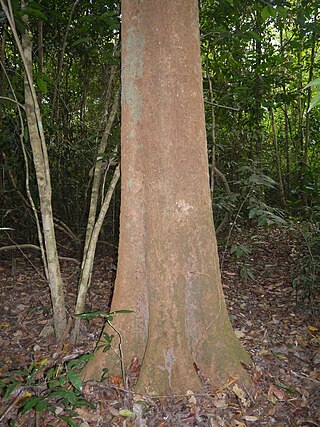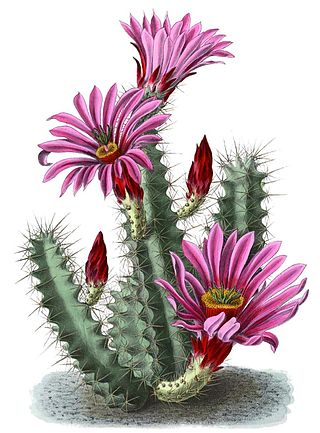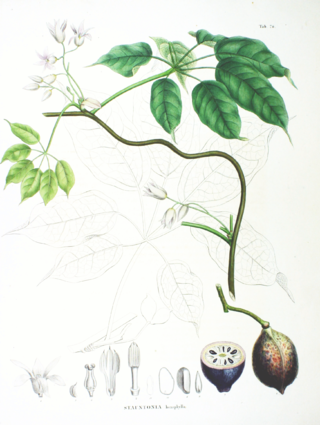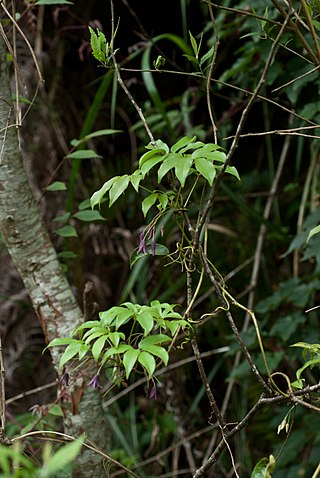
Parinari anamensis is a dicotyledonous plant species that was described by Henry Fletcher Hance from southern Vietnam. It has been called Annamese burada and is now placed in the family Chrysobalanaceae,. No subspecies are listed in the Catalogue of Life.
Quercus chrysocalyx is a tree species in the beech family Fagaceae; there are no known subspecies. It is native to Cambodia, China (Yunnan), Laos, Thailand, and Vietnam. It is placed in subgenus Cerris, section Cyclobalanopsis.
Utricularia capillacea is a species of carnivorous plant from the Lentibulariaceae family, Lamiales order, described by Carl Ludwig Willdenow. According to the Catalogue of Life Utricularia capillacea does not have known subspecies.

Magnolia dodecapetala is a species of plant in the genus Magnolia, family Magnoliaceae. It was described by a French naturalist named Lamarck, and it obtained the name from a Belgian botanist named Rafaël Herman Anna Govaerts.

Silene sorensenis, the three-flowered campion or Sorensen's catchfly, is a species of plant in the family Caryophyllaceae. It is found in the tundra of the Canadian Arctic Archipelago, the Northern Russian Far East and Greenland.

Bouea is an Asian genus of fruiting trees in the family Anacardiaceae. Species can be found in southern China, Indo-China and Malesia.

Veronica bellidioides is a flowering plant species in the genus Veronica of the family Plantaginaceae. It is native to Europe. This species was described by Carl von Linné.
Saxifraga consanguinea is a flowering plant species in the genus Saxifraga of the family Saxifragaceae.
Quercus treubiana is a member of the Quercus (oak) genus, placed in subgenus Cerris, section Cyclobalanopsis. It is found in the tropical mountain forests of Borneo and Sumatra at altitudes between 600 and 2200m. It is named for Melchior Treub, 1851–1910, who was until 1909 Director of the Bogor Botanical Gardens, Indonesia. It was first formally named by Karl Otto von Seemen in 1906 in the Bulletin de Département de l’Agriculture aux Indes Néerlandaises. It is also been referred to as Cyclobalanopsis treubiana (Seemen).
Amomum smithiae is a monocotyledonous plant species originally described by Yee Kiew Kam as Elettariopsis smithiae in the family Zingiberaceae. No subspecies are listed in the Catalogue of Life.
Stachyandra merana is a species of plant in the genus Stachyandra in the family Picrodendraceae.

Echinocereus enneacanthus is a species of flowering plant first described by George Engelmann.

Nothoscordum gracile, also known as slender false garlic, or fragrant onion, is a bulbous plant belonging to the Amaryllidaceae family. Native from southern Mexico to western South America, the species is used as an ornamental plant due to its showy inflorescences and the fragrance of its flowers.

Dichondra microcalyx, the mouse ear, is a species of plant in the family Convolvulaceae.

Stauntonia hexaphylla or Stauntonia vine is a plant in the family Lardizabalaceae.

Stauntonia purpurea is a plant in the family Lardizabalaceae.

Stauntonia chinensis is a plant in the family Lardizabalaceae. It is endemic to China, where it is distributed in Yunnan, Guangxi, Guangdong, Zhejiang, Jiangxi, Fujian, Hunan, Anhui, Hong Kong, Guizhou and other places. It grows at an altitude of 500 meters to 1,300 meters above sea level and can be found in dense forests in mountainous areas, thickets on the hillside or sparse forests along the streams in valleys.
Stauntonia trinervia is a plant in the family Lardizabalaceae. It is distributed in Guangdong and other parts of mainland China, and grows at an altitude of 350 to 500 meters above sea level in open forests beside water in valleys.
Stauntonia obovata is a plant in the family Lardizabalaceae. It is distributed in Taiwan and mainland China in Guangdong, Sichuan, Fujian, Guangxi, Jiangxi, Hong Kong, Hunan and other places. It grows in areas with an altitude of 300 to 800 meters, mostly in open forests or dense forests in mountain valleys.
Stauntonia brunoniana is a plant in the family Lardizabalaceae. It is distributed in Vietnam, India, Myanmar, and Yunnan in mainland China, and grows at an altitude of 900 to 1,500 meters above sea level, generally in mountain forests.










